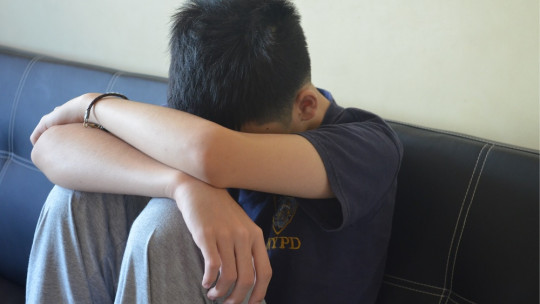All people have had some obsessive thought at some point, some thought, fear or doubt that we cannot get out of our heads even if we want to. Also, most of us have at some point had thoughts that do not embarrass or displease us, such as wishing another person that they do not get what we want for ourselves or the temptation to yell four times at the unscrupulous person who is talking on the phone at the cinema. Most people don’t give them much importance.
However, for those affected by Obsessive-Compulsive Disorder, these ideas generate great anxiety about their possible implications and possible consequences, so They try to perform different ritual actions to control their thoughts and take control again.
Most people with OCD consider and recognize that deep down these thoughts and fears have no basis that should really worry them and have no real effects on the world. Others don’t. Among the latter we can find cases in which obsessive ideas become delusions and they may even have hallucinations. Although this is something very unusual, There are cases of Obsessive-Compulsive Disorder with psychotic episodes We will talk about this in this article.
Obsessive-Compulsive Disorder
Obsessive-Compulsive Disorder or OCD is the condition characterized by the continued presence over time of obsessions, mental contents or ideas that appear intrusively in the subject’s mind without the subject being able to control them but which are recognized as their own and which in most cases are generators of a high level of anxiety. Frequently, a set of acts or rituals called compulsions appear along with these ideations, which are carried out with the aim of reducing the anxiety generated by the ideas or avoiding the possibility of obsessive thoughts occurring or having consequences in real life.
It is one of the mental disorders that causes the greatest suffering to those who suffer from it, since in most cases the subject is aware that they cannot control the appearance of their thoughts and that the acts they perform as a ritual do not They have a real effect beyond a temporary and brief calming, which in fact reinforces the future appearance of new thoughts. In fact, a vicious circle is established between obsession and compulsion that increasingly aggravates the anxiety that the subject suffers, feeding back the symptoms of the disorder.
The feeling is of lack of control over their own thinking, or even of confinement within a dynamic from which they cannot escape. Much of the problem is actually the excessive attempt to control thought and actively avoid the appearance of the thought that generates anxiety, which indirectly reinforces its appearance. Thus we find ourselves facing an egodystonic disorder.
It is common for there to be the presence of a certain level of magical thinking and thought-action fusion, unconsciously considering that it is possible that one’s thoughts can have an effect on real life despite consciously recognizing that this is not the case.
This disorder has serious repercussions on the daily lives of those who suffer from it, since the repeated presence of obsessions and compulsions can require a large number of hours and limit their personal, work and academic life. Personal relationships can deteriorate the subject also tends to isolate himself to avoid social rejection, and his work and academic performance can be greatly diminished by dedicating a large part of his attention and cognitive resources to avoiding obsession.
OCD with psychotic episodes: an atypical aspect
Generally, the subject with Obsessive-Compulsive Disorder is aware and recognizes that their obsessive thoughts and the compulsions they carry out are not based on a real basis, and they may come to consider them stupidity without being able to control them. This fact generates an even higher level of discomfort and suffering.
However, there are cases in which obsessive ideas are considered true and in which the subject is completely convinced of their veracity, not questioning them and turning them into explanations of reality. In these cases the ideas can be considered delusional, OCD acquiring psychotic characteristics
In these cases, considered and also called atypical obsessives or schizo-obsessives, it is observed that the insight necessary to detect that their behaviors have no real effect on what they intend to avoid is not present. Also in these cases compulsions may not be experienced as annoying or egodystonic but simply as something to do, without it seeming intrusive or forced. Another option is that the continued suffering of an obsessive idea ends up reactively triggering hallucinations or delusions as a way of trying to explain the functioning of the world or the situation experienced.
Three great possibilities
The comorbid presence of obsessive and psychotic symptoms is not particularly common, although in recent years there seems to be a certain increase in this joint pattern. The studies carried out say that there are three main possibilities:
1. Obsessive disorder with psychotic symptoms
We are facing the most prototypical case of Obsessive-Compulsive Disorder with psychotic episodes. In this clinical presentation, people who suffer from OCD may present transitory psychotic episodes derived from the transformation and elaboration of their ideas, in a way that is understandable depending on the persistence of obsessive ideation. These would be episodes that They will occur reactively to the mental exhaustion generated by anxiety
2. OCD with lack of insight
Another possibility of an obsessive disorder with psychotic symptoms arises from, as we have said previously, the absence of the ability to perceive the non-correspondence of the obsession with reality These subjects would have stopped seeing their ideas as anomalous and would consider that their ideas do not contain an overvaluation of their influence and responsibility. They generally tend to have a family history of severe psychopathology, and it is not strange that they only express anxiety about the consequences of not carrying out compulsions and not about the obsession itself.
3. Schizophrenia with obsessive symptoms
A third possible comorbid presentation of psychotic and obsessive symptoms occurs in a context in which obsessive-compulsive disorder does not actually exist. These would be those patients with schizophrenia who, during the condition or before the presence of psychotic symptoms They present obsessive characteristics, with repetitive ideas that they cannot control and a certain compulsiveness in his actions. It is also possible that some obsessive symptoms appear induced by the consumption of antipsychotics.
What causes this disorder?
The causes of any type of Obsessive-Compulsive Disorder, both those with psychotic features and those without, are largely unknown. However, there are different hypotheses in this regard, considering that OCD is not due to a single cause but rather has a multifactorial origin.
On a medical and neurological level , through neuroimaging it has been possible to observe the presence of hyperactivation of the frontal lobe and the limbic system, as well as an affectation of the serotonergic systems (which is why pharmacological treatment is usually based on antidepressants in those patients who require it) and dopaminergic. The involvement of the basal ganglia in this disorder has also been observed. Regarding those modalities of Obsessive-Compulsive Disorder with psychotic episodes, it has been observed that at the neuroimaging level they tend to have a smaller left hippocampus.
At a psychosocial level, OCD is more common in people with a sensitive nature who have received either an excessively rigid or very permissive education, which has generated in them the need to have control of their own thoughts and behavior. They tend to take hyper-responsibility for what happens around them and have a high level of doubt and/or guilt. Nor is it uncommon to suffer from bullying or some type of abuse that has led them to need, initially in an adaptive way for them, to control their thoughts. The association with psychotic symptoms may also be due to suffering from traumas or experiences that have generated a break with reality together with a predisposition to this type of symptomatology.
An existing hypothesis regarding the functioning of OCD is Mowrer’s two-factor theory , which proposes that the cycle of obsessions and compulsions is maintained by double conditioning. First, classical conditioning occurs in which the thought is associated with the anxious response, which in turn generates the need to escape from it, and subsequently, through operant conditioning, maintaining the avoidance or escape behavior through compulsion. Thus the compulsion is associated with the reduction of immediate discomfort, but does not have an effect on the actual aversive stimulus (the content of the thought). In this way, the appearance of future obsessive thoughts is not prevented but in fact facilitated.









